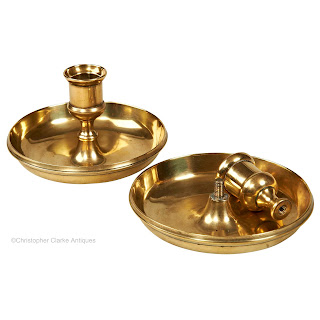From approximately 1735 through 1925, explorers, travellers, military officers, and European Royalty all employed a distinctive type of folding candlestick on their journeys. Perhaps because of their resemblance when packed for travel to a now-forgotten English pastry, these candlesticks are colloquially and affectionately referred to today as 'Brighton Buns.'
A Brighton Bun consists of two drip-pan bases that screw together in such a way that they form a circular bun. When unscrewed, the bases divide into two equal halves, revealing two loose candle cups. When upturned, the drip pans form the bases for two chamber candlesticks into which the candle cups are screwed. The candle cups are sometimes embellished with ring turnings, flared lips, or ejector slits through which the candle stubs may be removed. The more elaborate Brighton buns contain conical snuffers.
The bases of these elegant and useful travelling chamber candlesticks range in size from approximately 3 ¼ inches to 6 inches in diameter: Brighton Buns were made by casting, spinning, or pressing brass, bronze, and copper; rolling and spinning Britannia metal; hammering or pressing silver; or turning wood on a lathe. Examples have been recorded in a variety of woods, ranging from olivewood, yew, and elm to ebony and Karelian birch. By the early twentieth century, the traveller could order Brighton buns plated in silver, covered with 'Russia leather', 'American cloth,' or, for the more affluent, 'Crocodile leather.'
John Caspall has observed that 'Soon after their introduction, and in their early years, Brighton buns were invariably cast from brass or bronze, were always quite heavy, and carefully lathe-finished... Much lighter 'basin-halves' were formed by pressing from sheet material, and the rims were sufficiently thickened by rolling to permit a fine circumferential thread to be cut.'
Although the majority of Brighton buns currently on the market are of English manufacture, and more often than not made from pressed or cast brass, they were in fact made in a variety of countries, including Germany, Austria, and the United States.
 |
| Britannia Metal Mikitary Candlesticks by James Dixon & Sons |
During the height of British imperialism, travelling brass candlesticks found their way to some of the farthest corners of the Empire. They were considered essential travelling kit by such early explorers of the Canadian frontier as David Thompson (1770-1857), a geographer who was based in Rocky Mountain House, a fur-trading post on the North Saskatchewan River in Alberta, British Columbia, at the turn of the nineteenth century. In A History of Rocky Mountain House, Hugh Aylmer Dempsey published lists from early nineteenth century invoices and inventories that show the kinds of goods shipped by the North West Company's Columbia Department for the Indian trade in Montreal. In addition to axes, blankets, belts, garden seeds, ivory combs, playing cards, chocolate, coffee, cinnamon, cloves and camphor requested for the years 1807-1808 there is an entry for 'candlesticks, brass camp.'
Not only were Brighton Buns used by senior officers in the British army and intrepid explorers of the Canadian frontier, but also by European royalty. An exceptional pair of sterling silver Brighton buns engraved with the monogram of Queen Charlotte Sophia, the consort of King George III (r: 1760-1820), and bearing hallmarks for 1808, appeared on the market in 2000. Franz Joseph I, emperor of Austria (r: 1848-1916) was an avid collector of lighting devices that were popular in Austria and the Alpine countries from the fifteenth to the eighteenth centuries. Among the devices in his collection was a pair of Brighton buns that Franz Joseph's cataloguer called a 'traveller's candleholder, which when opened and put together, provides two candle sockets and two bases.'
Brighton Buns were also popular in America during the Civil War and well into the late 19th century. Illustrations of 'Camp Candlesticks' appear in the Catalogue of Arms and Military Goods published by the New York military furnishers Schuyler, Hartley & Graham, in 1864. Similarly, in 1896, the Gorham Manufacturing Company of Providence, Rhode Island, illustrated a 'Travelling Candlestick' in their Catalogue of Sterling Silverware.
Though the Army & Navy Co-operative Society, arguably the most popular military and colonial outfitter of the Victorian and Edwardian periods, did not include Brighton Buns in their Price List of 1881, by 1907 they were offering Brighton Buns for sale under the catalogue headings 'Barrack Furniture and Camp Equipment,' where they are referred to as 'Brass Folding Candlesticks.' They were also offered for sale through the Ironmongery Department, where they are described as 'Military, brass.' At the same time, under the heading 'Stationery Fancy Goods,' they offered 'Travelling Candlesticks' covered in 'Russia leather,' 'Crocodile Leather,' 'Brass, 3 3/8 in. diameter,' 'Brass 3 7/8 in. diameter,' and 'Silver, 3 5/8 in. diameter.' Similarly, around 1910, Harrod's Supplementary Export Price List offered 'Brass Candlesticks,' both 'large' and 'small' under the catalogue heading 'Barrack Furniture and Camp Equipment Department.' Brighton Buns were still being advertised for military use by the Army & Navy Stores as late as 1925, when a pair of 'Brass Folding Candlesticks' is illustrated in the catalogue in the 'Barrack Furniture and Camp Equipment Department.'

In 1787, A. Hepplewhite and Company published its belief that 'to unite elegance and utility and blend the useful with the agreeable has ever been considered a difficult, but an honourable task.' Brighton buns realize this maxim to the letter.
Nicholas Brawer is the author of British Campaign Furniture: Elegance Under Canvas, 1740-1914, published in 2001 by Harry N. Abrams, and was the curator of Britain's Portable Empire: Campaign Furniture of the Georgian, Victorian and Edwardian Periods, an exhibition held in 2001 at the Katonah Museum of Art in Katonah, New York. Nick has a shop in New York at 28 East 72nd Street at Madison Avenue.
The examples of Brighton Buns illustrated here are ones that we have sold. Further examples of travelling candlesticks can be seen on our website by searching 'Brighton Bun' or clicking on this
link.

























